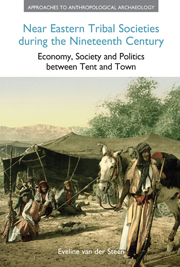 Near Eastern Tribal Societies during the Nineteenth Century
Near Eastern Tribal Societies during the Nineteenth Century Book contents
- Frontmatter
- Dedication
- Contents
- Acknowledgements
- Introduction
- 1 What is a tribe?
- 2 Travellers in the Levant during the nineteenth century
- 3 The dynamics of territorial and power structures
- 4 Oral traditions
- 5 Tribal society and its relation to the landscape
- 6 Tribal institutions
- 7 Relations between the tribes and the state
- 8 From tribe to tribal state: three case studies
- 9 The economy of tribal societies
- 10 Ethnicity and the sense of belonging
- 11 Women in tribal societies
- 12 Religion and folklore
- 13 Back in time: historical parallels
- Notes
- References
- Index
13 - Back in time: historical parallels
- Frontmatter
- Dedication
- Contents
- Acknowledgements
- Introduction
- 1 What is a tribe?
- 2 Travellers in the Levant during the nineteenth century
- 3 The dynamics of territorial and power structures
- 4 Oral traditions
- 5 Tribal society and its relation to the landscape
- 6 Tribal institutions
- 7 Relations between the tribes and the state
- 8 From tribe to tribal state: three case studies
- 9 The economy of tribal societies
- 10 Ethnicity and the sense of belonging
- 11 Women in tribal societies
- 12 Religion and folklore
- 13 Back in time: historical parallels
- Notes
- References
- Index
Summary
What has been will be again,
what has been done will be done again;
there is nothing new under the sun.
(Ecclesiastes 1:9)Introduction
Barfield (2003) expands on the difficulties that a modern ethnographer encounters in his or her work when explaining the past. Our information, our clues about the past, are hidden in sources of a widely varying kind, each demanding a different interpretational approach. It consists of texts, archaeological sites and settlement patterns. To interpret these sources, we inevitably use the present. We use analogy, often combined with experimental archaeology. Fernand Braudel (1949) introduced the concept of the longue durée, the long, slow cycles of history that lay underneath the political, social and natural events that create the historical narrative. The current of the longue durée in a particular part of the world is determined by geography, climate and social structure, all of which change little, if at all, over time. The concept of the longue durée is the justification for the work of the ethnographer. In this study it is the justification for the continuity of tribalism, the way of life that determined society in the Near East until the beginning of the twentieth century.
- Type
- Chapter
- Information
- Near Eastern Tribal Societies during the Nineteenth CenturyEconomy, Society and Politics between Tent and Town, pp. 254 - 269Publisher: Acumen PublishingPrint publication year: 2013
